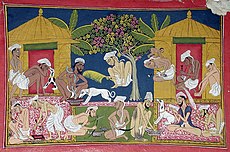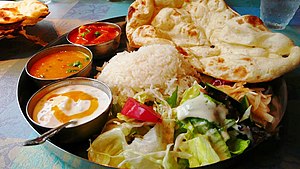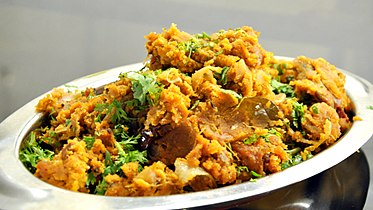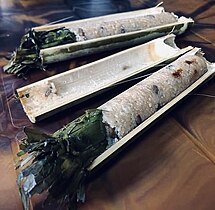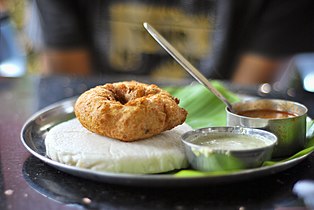Indian cuisine/ja: Difference between revisions
Created page with "=== ベンガル === {{Main/ja|Bengali cuisine/ja}} thumb|[[Pitha/ja|ピテ・プリ]] ムガル料理はベンガル人の味覚に普遍的な影響を与えており、ペルシャ料理やイスラム料理をこの地域に導入しただけでなく、ギーを使ったマリネなど、より手の込んだ調理法も導入した。魚、肉、米、牛乳、砂糖はすべてベンガル料理において重..." |
Created page with "ベンガル料理は、चारव्य (チョルビョ) または米や魚のように噛んで食べる食品、যেমন (チョショ) またはアンバルやタクのように吸って食べる食品, লেহ্য (レヒョ) またはチャツネのように舐めて食べる食品、পেয়ে (ペエ) または主に牛乳などの飲み物を含む食品の4つの異なる種類の料理に細分化できる。 File:Shorshe Pabda (Pabo catfish..." Tags: Mobile edit Mobile web edit |
||
| Line 143: | Line 143: | ||
ムガル料理はベンガル人の味覚に普遍的な影響を与えており、ペルシャ料理やイスラム料理をこの地域に導入しただけでなく、ギーを使ったマリネなど、より手の込んだ調理法も導入した。魚、肉、米、牛乳、砂糖はすべてベンガル料理において重要な役割を果たしている。 | ムガル料理はベンガル人の味覚に普遍的な影響を与えており、ペルシャ料理やイスラム料理をこの地域に導入しただけでなく、ギーを使ったマリネなど、より手の込んだ調理法も導入した。魚、肉、米、牛乳、砂糖はすべてベンガル料理において重要な役割を果たしている。 | ||
ベンガル料理は、चारव्य (チョルビョ) または米や魚のように噛んで食べる食品、যেমন (チョショ) またはアンバルやタクのように吸って食べる食品, লেহ্য (レヒョ) またはチャツネのように舐めて食べる食品、পেয়ে (ペエ) または主に牛乳などの飲み物を含む食品の4つの異なる種類の料理に細分化できる。 | |||
[[File:Shorshe Pabda (Pabo catfish in Mustard paste)-Home,kolkata-West Bengal-IMG 0001.jpg|thumb|ショルシェ・パブダ(マスタードペーストのパボ・ナマズ)]] | |||
[[File:Shorshe Pabda (Pabo catfish in Mustard paste)-Home,kolkata-West Bengal-IMG 0001.jpg|thumb| | 19世紀には、多くの[[:en:Odia people|オリヤー語]]を話す料理人が[[:en:Bengal|ベンガル]]で雇用され、その結果、両地域間でいくつかの食品が伝達された。ベンガル料理は、インド亜大陸で伝統的に発展した唯一の多皿料理の伝統であり、フランス料理の現代的な[[:en:service à la russe|ロシア式サービス]]のスタイルと構造が類似しており、料理は一度にすべて提供されるのではなく、コースごとに提供される。 | ||
<div lang="en" dir="ltr" class="mw-content-ltr"> | <div lang="en" dir="ltr" class="mw-content-ltr"> | ||
Revision as of 17:10, 19 May 2025
| この記事はシリーズの一部である |
| インド料理 |
|---|
 |
|
|
| 以下一連のシリーズの一部 |
| インドの文化 |
|---|
 |
|
|
インド料理とは、インドに固有の多様な地域料理および伝統料理から成るものである。土壌、気候、文化、民族集団、職業の多様性により、これらの料理は大きく異なり、現地で入手可能な香辛料、ハーブ、野菜、果物を用いている。
インド料理は、宗教、特にヒンドゥー教およびイスラム教、文化的な選択や伝統の影響を強く受けている。
侵略、貿易関係、植民地主義といった歴史的出来事は、特定の食材をこの国にもたらす役割を果たしてきた。コロンブスの新大陸発見により、新世界から多くの新しい野菜や果物がインドにもたらされた。ジャガイモ、トマト、トウガラシ、ピーナッツ、グアバなどの多くは、インドの多くの地域で主食のひとつとなっている。
インド料理は国際関係の歴史に影響を与えてきた。インドとヨーロッパとの間の香辛料貿易は、ヨーロッパの大航海時代の主なきっかけとなった。香辛料はインドから購入され、ヨーロッパやアジア各地で取引された。インド料理は世界各地の料理に影響を与えており、特にヨーロッパ(特にイギリス)、中東、南部アフリカ、東アフリカ、東南アジア、北アメリカ、モーリシャス、フィジー、オセアニア、カリブの料理に強い影響を及ぼしている。
歴史
インド料理は、インド亜大陸におけるさまざまな集団や文化が関わってきた8,000年にわたる歴史を反映しており、現代インドに見られる多様な風味や地域料理を生み出している。後には、イギリス人やポルトガル人との貿易により、すでに多様であったインド料理にさらなる影響が加わった。
先史時代およびインダス文明
関連項目:メルッハ、インダス・メソポタミア関係、インドの海洋史
紀元前9000年以降、肥沃な三日月地帯とインダス文明の間で、新石器革命および農業の拡散の結果として、間接的な接触の初期段階があったと考えられている。紀元前7000年頃には、農業が肥沃な三日月地帯からインダス地域へと広がり、小麦や大麦の栽培が始まった。ゴマや瘤牛(ズブ牛)は、現地の農耕社会で家畜化された。メヘルガルは、南アジアにおける最古級の農耕・牧畜の痕跡が確認された遺跡のひとつである。紀元前4500年頃から1900年頃にかけて、シュメール文明を築いたシュメール人は、インド・ヨーロッパ語族にもセム語族にも属さない言語を話しており、当初はインドから来た可能性があり、インドのドラヴィダ系民族の祖先と関係していた可能性がある。
紀元前3000年頃までに、ウコン、カルダモン、黒コショウ、マスタードがインドで収穫されていた。
紀元前2350年頃以降、インダスからメソポタミアのウルへの輸入品の証拠が見つかっており、海洋東南アジアのモルッカ諸島原産と考えられるクローブ(丁子)の花頭が、紀元前2千年紀のテルカの遺跡で発見されている。アッカド帝国の記録には、メルッハからメルッハ船によって輸入された木材、カーネリアン、象牙について言及されており、メルッハは一般にメソポタミアにおけるインダス文明の名称とされている。
ヴェーダ時代
古代のヒンドゥー教文献『’’マハーバーラタ’’』には、米と野菜を一緒に炊いた料理について言及されており、"プラオ"または"パッラオ"という語が、サンスクリットの古典文献、たとえば『ヤージュニャヴァルキヤ・スムリティ』などに見られる。アーユルヴェーダは、食事、瞑想、ヨガを含むホリスティックな健康アプローチを扱う古代インドの養生体系である。
古代
インドにおける初期の食生活は、主に豆類、野菜、果物、穀物、乳製品、および蜂蜜で構成されていた。今日の主食には、さまざまなレンズ豆(’’ダール’’)、全粒小麦粉(’‘aṭṭa’’)、米、そしてシコクビエ(’‘bājra’’)が含まれ、これらは紀元前6200年からインド亜大陸で栽培されてきた。
時代が進むにつれて、シュラマナ運動の影響で、一部の人々は菜食主義を受け入れるようになった。温暖な気候が多種多様な果物、野菜、穀物の通年栽培を可能にした。
ヨーガの伝統において、食品を’’サットヴィック’’、’’ラジャシック’’、’’タマシック’‘に分類する食物分類法が発展した。’’バガヴァッド・ギーター’’では、特定の食事法が規定されている(第17章、第8–10節)。
牛肉の消費は禁忌とされており、これはヒンドゥー教において牛が神聖視されているためである。インドのヒンドゥー教徒は通常牛肉を食べないが、ケーララ州、南部タミル・ナードゥ州の一部、北東部では例外がある。
古代インドの経典に登場する食品

多くの古代インドのレシピは歴史の中で失われたが、古代および先史時代のインドで何が食べられていたかは、古代の文献からうかがい知ることができる。
- 大麦 — (ヴェーダ語および古典サンスクリット語で’‘ヤヴァ’‘と呼ばれる)’’リグ・ヴェーダ’‘や他のインドの聖典において、古代インドの主要穀物の1つとしてたびたび言及されている
- ベテルの葉 — 主にビンロウジやタバコを噛む際の包みとして用いられるが、料理にも使われ、特に生でピリッとした風味を加える
- パンノキ(パンの実) — コンカニ語で’‘jeev kadge phodi’‘と呼ばれる揚げ物がカルナータカ州およびケーララ州の沿岸部での郷土料理
- ヒヨコマメ — ‘’ミルチ・バジ’‘や’‘mirapakaya bajji’‘のように、粉にして人気のある料理が作られる
- カード — インド亜大陸に由来する伝統的なヨーグルトまたは発酵乳製品で、通常は牛乳から、時には水牛やヤギの乳から作られる
- イチジク — アフガニスタンからポルトガルまで栽培されており、インドのクマオン丘陵のピトラガルでも育てられている
- ギー — 古代インド発祥の澄ましバターの一種で、インド亜大陸、中東料理、伝統医学、宗教儀式で広く用いられる
- ブドウ酒 — カウティリヤの紀元前4世紀後半の記述にインドでのブドウ由来のワインの初出が見られる
- 蜂蜜 — ヴェーダおよびアーユルヴェーダ文献に、精神的かつ治療的用途が記録されている
- マンゴー — ジャイナ教の女神アンビカーは、伝統的にマンゴーの木の下に座る姿で表される
- カラシ(マスタード) — 褐色カラシナはインダス文明で栽培されていた香辛料で、現在もインド亜大陸で重要なスパイス
- ザクロ — 一部のヒンドゥー教伝統では、大地の女神ブーミデヴィやガネーシャ神と関連づけられ、繁栄と多産の象徴
- 米 — 紀元前5000年頃からインド亜大陸で栽培
- ライスケーキ — 多様な種類が存在する
- ローズアップル — 果物として食され、また’‘chambakka achar’‘として漬物にもされる
- サフラン — スペインからカシミールにかけての帯状地域で主に栽培される
- 塩 — ヒンドゥー教では非常に縁起の良い物質とされ、上棟式や結婚式などの宗教儀式で使われる。またジャイナ教では、信仰の印として生米と一緒に供えたり、火葬後の遺灰に振りかけたりする習慣がある
- ゴマ油 — 韓国、中国、そしてカルナータカ、アーンドラ・プラデーシュ、タミル・ナードゥなどの南インドで人気で、オリーブオイルの地中海での使用に似ている
- ソルガム(モロコシ) — 一般に’‘jwaarie’’、’‘jowar’’、’‘jola’’、’‘jondhalaa’’と呼ばれ、主要な栄養源のひとつ
- 砂糖 — 古代からインド亜大陸で生産され、カイバル峠を通じて現代のアフガニスタンへと広まった
- サトウキビ — 最古の結晶糖の生産は北インドで始まった。古代サンスクリット語とパーリ語の文献にその証拠が見られる
- ウコン(ターメリック) — 南アジアと中東料理で広くスパイスとして使用される
中世から16世紀まで
中世インドにおいては、グプタ朝をはじめとする複数の王朝が栄えた。この時代のインドへの渡航により、茶などの新たな料理法や食材が地域にもたらされた。
その後、中央アジアの文化を持つ諸部族がインドに侵入し、インド料理と中央アジア料理が融合したムガル料理が誕生した。サフランなどの香辛料を多用することが特徴である。
植民地時代
ポルトガル人およびイギリス人の支配下では、ベーキングのような新たな調理法や、新大陸およびヨーロッパ由来の食品が導入された。インド亜大陸の料理で人気のある新大陸産の野菜には、トマト、ジャガイモ、サツマイモ、ピーナッツ、カボチャ、チリなどがある。サツマイモ、ジャガイモ、アマランサス、ピーナッツ、キャッサバを原料とするサゴといった多くの新大陸野菜は、ヒンドゥー教の断食日に摂取が許されている。カリフラワーは1822年にイギリス人によって導入された。18世紀末から19世紀初頭には、スコットランド人ロバート・リンジーの自伝に、シレット地方出身のサイード・ウッラーという人物がリンジー家のためにカレーを調理したという記録があり、これはイギリスにおけるインド料理の最古の記録の一つと考えられている。
-
ニマトナーマー・イ・ナースィルッディーン・シャーヒーより一頁。キールの作り方という美食とレシピの芸術が記録されている。
食材

インド料理の主食には、バジュラ(シコクビエ)、米、アッタ(全粒小麦粉)、およびさまざまな種類のレンズ豆(例:’‘マスール’’(主に赤レンズ豆)、’‘トゥール’’[トゥワール豆]、’’ウラド’’(黒グラム)、’‘ムング’’[緑豆])などがある。レンズ豆は、全形、皮むき(例:’‘ドゥーリ・ムング’‘や’‘ドゥーリ・ウラド’’)、または割った状態で使用される。割ったレンズ豆(’‘ダール’’)は広く使われている。その他の豆類では、’‘チャナ’‘や’‘チョーレ’’(ヒヨコ豆)、’’ラジマ’’(インゲンマメ)、’‘ロビヤ’’(ササゲ)が特に北インドで一般的である。’‘チャナ’‘と’‘ムング’’はベサン(ひよこ豆粉)としても加工される。
多くのインド料理は植物油で調理されるが、ピーナッツ油は北部および西部インドで人気があり、マスタード油は東インド、ココナッツ油は西海岸、特にケーララ州や南部タミル・ナードゥ州でよく使われている。ギンゲリー(ごま)油は香ばしくナッツのような香りがするため、南インドで広く用いられている。
近年では、ひまわり油、ベニバナ油、綿実油、大豆油などもインド全土で人気を博している。硬化植物油である’’ヴァナスパティ・ギー’‘もよく使用されている。バターをベースとしたギー、すなわち’‘デシ・ギー’’も一般的である。
インド料理では多様な肉類が使われるが、最も一般的に消費されているのは鶏肉とマトンである。魚介類や牛肉も一部地域では食されるが、沿岸部や北東部を除いては広く消費されているわけではない。
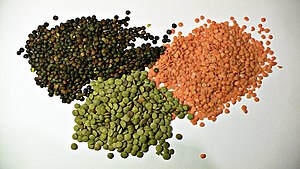
インド料理で最も重要かつ頻繁に使用される香辛料・風味付け食材には、唐辛子(’‘ミルチ’’。コロンブス交易を通じて16世紀にメキシコからポルトガル人によりもたらされた)、黒マスタードシード(’‘サルソ’’)、カルダモン(’‘エライチ’’)、クミン(’‘ジーラ’’)、ターメリック(’‘ハルディ’’)、ヒング、ショウガ(’‘アドラク’’)、コリアンダー(’‘ダニヤ’’)、ニンニク(’‘ラスーン’’)などがある。
よく使われるスパイスミックスのひとつが’’ガラムマサラ’‘であり、通常は7種の乾燥香辛料を特定の割合で混ぜた粉末である。これには黒カルダモン、シナモン(’‘ダルチニ’’)、クローブ(’‘ラウング’’)、クミン(ジーラ)、黒胡椒、コリアンダーシード、八角などが含まれる。
地域ごとに’‘ガラムマサラ’‘の配合は異なり、各料理人が独自のブレンドを持つこともある。’‘ゴダ・マサラ’‘はマハーラーシュトラ州で人気の、甘みを帯びた類似スパイスミックスである。風味付けに使用される代表的な葉には、ベイリーフ(’’テージパッタ’’)、コリアンダーの葉、フェヌグリーク(’’メティ’’)の葉、ミントの葉がある。カレーリーフとその根は、グジャラート料理や南インド料理に特有の風味付けに用いられる。甘味料理には、カルダモン、サフラン、ナツメグ、バラの花弁エッセンスなどがしばしば用いられる。
地域料理
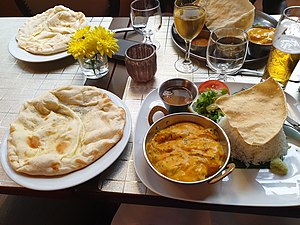
インドの多様な地域では、現地の文化、地理的条件(海、砂漠、山岳地帯からの距離)、経済状況の違いにより、料理が異なる。また、どの果物や野菜が熟しているかによって、季節によっても変化する。
アンダマン・ニコバル諸島
魚介類は、アンダマン・ニコバル諸島の料理において重要な役割を果たしている。先住民族であるアンダマン人の伝統的な食生活の主食は、狩猟と採集によって得られた根菜、蜂蜜、果物、肉、魚である。一部の昆虫も珍味として食べられていた。しかし、インド本土からの移民により、料理に変化が生じている。
アーンドラ・プラデーシュ州
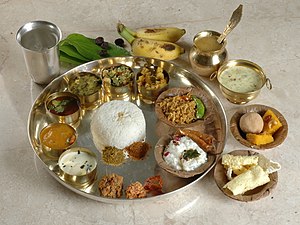
アーンドラ・プラデーシュ州の料理は、ラーヤラシーマ地方と沿岸部のアーンドラ地方の2つのテルグ語圏に属し、テルグ料理の一部である。アーンドラ・プラデーシュ州の料理は、スパイスを多用することと、タマリンドを使用することで知られている。
魚介類は州の沿岸地域で一般的である。米は主食であり(南インドのすべての州と同様)、pappu(レンズ豆)や pulusu(シチュー)のようなレンズ豆の調理法や、スパイシーな野菜やカレーと一緒に食べられる。
アーンドラでは、ボトルひょうたんやナスなどの葉物野菜や野菜が通常 dal に加えられる。漬物は地元の料理に不可欠な部分であり、人気のあるものには、avakaya や maagaya のようなマンゴーベースの漬物、gongura(スイバの葉から作られた漬物)、usirikaya(グーズベリーまたは amla)、nimmakaya(ライム)、トマトの漬物などがある。
ペルグ(ヨーグルト)は、辛さを和らげる方法として、食事によく加えられる。朝食の品には、ドーサ、pesarattu(緑豆の ドーサ)、ワダ'、イドーリ などがある。
アルナーチャル・プラデーシュ州

アルナーチャル・プラデーシュ州の主食は米であり、魚、肉、葉物野菜と共に食される。アルナーチャルの先住民族は肉食であり、魚、卵、牛肉、鶏肉、豚肉、羊肉を料理に用いる。
多くの種類の米が使われる。葉で包まれた茹でた餅は人気のある軽食である。トゥクパ は、この地域のモンパ族の間で一般的な麺料理の一種である。
レタスは最も一般的な野菜であり、通常、生姜、コリアンダー、青唐辛子と共に茹でることで調理される。
発酵させた米またはキビから作られた Apong またはライスビールは、アルナーチャル・プラデーシュ州で人気のある飲料であり、爽やかな飲み物として消費される。
アッサム州
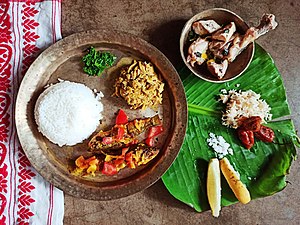
アッサム料理は、異なる土着のスタイルが混ざり合ったものであり、地域によってかなりの違いがあり、いくつかの外部からの影響も受けている。スパイスの使用が限られていることで知られているが、アッサム料理は、固有のハーブ、果物、野菜を新鮮なまま、乾燥させて、または発酵させて使用することによる強い風味を持つ。
米は主食であり、いくつかのモチ米を含む非常に多様な固有の米の種類がアッサムの料理の一部である。魚、一般的には淡水魚が広く食べられている。その他の非ベジタリアン食品には、鶏肉、鴨肉、ハト、カタツムリ、カイコ、昆虫、ヤギ肉、豚肉、鹿肉、カメ、オオトカゲなどが含まれる。
この地域の料理は、主にバーベキュー、蒸し料理、または茹でるというシンプルな調理法を用いる。主材料を加える前にスパイスをゆっくりと炒める Bhuna は、一般的にインド料理では一般的であるが、アッサムの料理には見られない。
アッサムの伝統的な食事は、主成分にちなんで名付けられた料理のクラスである khar で始まり、酸味のある料理である tenga で終わる。自家製のライスビールまたはライスワインが食事の前に供される。料理は通常、青銅製の食器で供される。
ベンガル

ムガル料理はベンガル人の味覚に普遍的な影響を与えており、ペルシャ料理やイスラム料理をこの地域に導入しただけでなく、ギーを使ったマリネなど、より手の込んだ調理法も導入した。魚、肉、米、牛乳、砂糖はすべてベンガル料理において重要な役割を果たしている。
ベンガル料理は、चारव्य (チョルビョ) または米や魚のように噛んで食べる食品、যেমন (チョショ) またはアンバルやタクのように吸って食べる食品, লেহ্য (レヒョ) またはチャツネのように舐めて食べる食品、পেয়ে (ペエ) または主に牛乳などの飲み物を含む食品の4つの異なる種類の料理に細分化できる。

19世紀には、多くのオリヤー語を話す料理人がベンガルで雇用され、その結果、両地域間でいくつかの食品が伝達された。ベンガル料理は、インド亜大陸で伝統的に発展した唯一の多皿料理の伝統であり、フランス料理の現代的なロシア式サービスのスタイルと構造が類似しており、料理は一度にすべて提供されるのではなく、コースごとに提供される。
Bengali cuisine differs according to regional tastes, such as the emphasis on the use of chilli pepper in the Chittagong district of Bangladesh However, across all its varieties, there is predominant use of mustard oil along with large amounts of spices.
The cuisine is known for subtle flavours with an emphasis on fish, meat, vegetables, lentils, and rice. Bread is also a common dish in Bengali cuisine, particularly a deep-fried version called luchi is popular. Fresh aquatic fish is one of its most distinctive features; Bengalis prepare fish in many ways, such as steaming, braising, or stewing in vegetables and sauces based on coconut milk or mustard.
East Bengali food, which has a high presence in West Bengal and Bangladesh, is much spicier than the West Bengali cuisine, and tends to use high amounts of chilli, and is one of the spiciest cuisines in India and the World.
Shondesh and Rashogolla are popular dishes made of sweetened, finely ground fresh cheese. For the latter, West Bengal and neighboring Odisha both claim to be the origin of dessert. Each state also has a geographical indication for their regional variety of rasgulla.
The cuisine is also found in the state of Tripura and the Barak Valley of Assam.
Bihar

Bihari cuisine may include litti chokha, a baked salted wheat-flour cake filled with sattu (baked chickpea flour) and some special spices, which is served with baigan bharta,
Among meat dishes, meat saalan is a popular dish made of mutton or goat curry with cubed potatoes in garam masala.
Dalpuri is another popular dish in Bihar. It is salted wheat-flour bread, filled with boiled, crushed, and fried gram pulses.
Malpua is a popular sweet dish of Bihar, prepared by a mixture of maida, milk, bananas, cashew nuts, peanuts, raisins, sugar, water, and green cardamom. Another notable sweet dish of Bihar is balushahi, which is prepared by a specially treated combination of maida and sugar along with ghee, and the other worldwide famous sweet, khaja is made from flour, vegetable fat, and sugar, which is mainly used in weddings and other occasions. Silao near Nalanda is famous for its production.
During the festival of Chhath, thekua, a sweet dish made of ghee, jaggery, and whole-meal flour, flavoured with aniseed, is made.
Other food items that are quite prominent in Bihar are, Pittha, Aaloo Bhujiya, Reshmi Kebab, Palwal ki mithai, and Puri Sabzi.
Chandigarh

Chandigarh, the capital of Punjab and Haryana is a city of 20th-century origin with a cosmopolitan food culture mainly involving North Indian cuisine. People enjoy home-made recipes such as paratha, especially at breakfast, and other Punjabi foods like roti which is made from wheat, sweetcorn, or other glutenous flour with cooked vegetables or beans. Sarson da saag and dal makhani are well-known dishes among others. Popular snacks include gol gappa (known as panipuri in other places). It consists of a round, hollow puri, fried crisp and filled with a mixture of flavoured water, boiled and cubed potatoes, bengal gram beans, etc.
Chhattisgarh

Chhattisgarh cuisine is unique in nature and not found in the rest of India, although the staple food is rice, like in much of the country. Many Chhattisgarhi people drink liquor brewed from the mahuwa flower palm wine (tadi in rural areas). Chhattisgarhi cuisines varies as per special occasions and festivals like Thethari and Khurmi, fara, gulgule bhajiya, chausela, chila, aaersa are prepared in regional festivals. The tribal people of the Bastar region of Chhattisgarh eat ancestral dishes such as mushrooms, bamboo pickle, bamboo vegetables, etc.
Dadra and Nagar Haveli
The local cuisine resembles the cuisine of Gujarat. Ubadiyu is a local delicacy made of vegetables and beans with herbs. The common foods include rice, roti, vegetables, river fish, and crab. People also enjoy buttermilk and chutney made of different fruits and herbs.
Daman and Diu
Daman and Diu is a union territory of India which, like Goa, was a former colonial possession of Portugal. Consequently, both native Gujarati food and traditional Portuguese food are common. Being a coastal region, the communities are mainly dependent on seafood. Normally, rotli and tea are taken for breakfast, rotla and saak for lunch, and chokha along with saak and curry are taken for dinner. Some of the dishes prepared on festive occasions include puri, lapsee, potaya, dudh-plag, and dhakanu. While alcohol is prohibited in the neighbouring state of Gujarat, drinking is common in Daman and Diu. Better known as the "pub" of Gujarat. All popular brands of alcohol are readily available.
Delhi

Delhi was once the capital of the Mughal empire, and it became the birthplace of Mughlai cuisine. Delhi is noted for its street food. The Paranthewali Gali in Chandani Chowk is just one of the culinary landmarks for stuffed flatbread (parathas).
Delhi has people from different parts of India, thus the city has different types of food traditions; its cuisine is influenced by the various cultures. Punjabi cuisine is common, due to the dominance of Punjabi communities.
Delhi cuisine is actually an amalgam of different Indian cuisines modified in unique ways. This is apparent in the different types of street food available. Kababs, kachauri, chaat, Indian sweets, Indian ice cream (commonly called kulfi), and even Western food items like sandwiches and patties, are prepared in a style unique to Delhi and are quite popular.
Goa

The area has a tropical climate, which means the spices and flavours are intense. Use of kokum is a distinct feature of the region's cuisine.
Goan cuisine is mostly seafood and meat-based; the staple foods are rice and fish. Kingfish (vison or visvan) is the most common delicacy, and others include pomfret, shark, tuna, and mackerel; these are often served with coconut milk. Shellfish, including crabs, prawns, tiger prawns, lobster, squid, and mussels, are commonly eaten.
The cuisine of Goa is influenced by its Hindu origins, 400 years of Portuguese colonialism, and modern techniques.
Bread, introduced by the Portuguese, is very popular, and is an important part of the Goan breakfast, most frequently in the form of toast.
Tourism in the area adds an international aspect, hence vegetarianism has become quite favored.
Gujarat
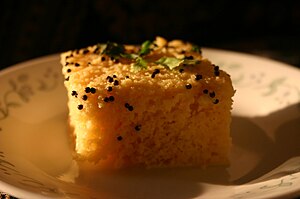
Gujarati cuisine is primarily vegetarian. The typical Gujarati thali consists of roti (rotlii in Gujarati), daal or kadhi, rice, sabzi/shaak, papad and chaas (buttermilk).
Sabzi is a dish of different combinations of vegetables and spices which may be stir fried, spicy or sweet. Gujarati cuisine can vary widely in flavour and heat based on personal and regional tastes. North Gujarat, Kathiawad, Kachchh, and South Gujarat are the four major regions of Gujarati cuisine.
Many Gujarati dishes are simultaneously sweet, salty (like handvo), and spicy. In mango season, keri no ras (fresh mango pulp) is often an integral part of the meal. Spices also vary seasonally. For example, garam masala is used much less in summer.
Gujarati snacks include sev khamani, khakhra, dal vada, methi na bhajiya, khaman, bhakharwadi and more.
Regular fasting, with diets limited to milk, dried fruit, and nuts, is a common practice,
Haryana

Cattle being common in Haryana, dairy products are a common component of its cuisine.
Specific regional dishes include kadhi, pakora, besan masala roti, bajra aloo roti, churma, kheer, bathua raita, methi gajar, singri ki sabzi and tomato chutney.
In the past, its staple diet included bajra khichdi, rabdi, onion chutney, and bajra ki roti. In non-vegetarian cuisine it includes kukad kadhai and chicken tikka masala.
Lassi, sharbat, nimbu pani and labsi (a mixture of bajra flour and lassi) are three popular non-alcoholic beverages in Haryana. However, liquor stores are common there, which cater to a large number of truck drivers.
Himachal Pradesh
The daily diet of Himachal people is similar to that of the rest of North India, including lentils, broth, rice, vegetables, and bread, although non-vegetarian cuisine is preferred. Some of the specialities of Himachal include sidu,patande, chukh, rajmah, and til chutney.
Jammu and Kashmir

The cuisine of Jammu and Kashmir is from two regions of the state: Jammu division and Kashmir Valley. Kashmiri cuisine has evolved over hundreds of years. Its first major influence was the food of the Kashmiri Hindus and Buddhists.
The cuisine was later influenced by the cultures which arrived with the invasion of Kashmir by Timur from the area of modern Uzbekistan. Subsequent influences have included the cuisines of Central Asia and the North Indian plains.

The Jammu region is famous for its sund panjeeri, patisa, rajma with rice and Kalari cheese.
Dogri food includes ambal (sour pumpkin dish), kulthein di dal, dal chawal, maa da madra (black gram lentils in yogurt) and Uriya.
Many types of pickles are made including mango, kasrod, and girgle. Street food is also famous which include various types of chaats, specially gol gappas, gulgule, chole bhature, rajma kulcha and dahi bhalla.
Jharkhand
Staple foods in Jharkhand are rice, dal and vegetables. Famous dishes include chirka roti, pittha, malpua, dhuska, arsa roti and litti chokha.
Local alcoholic drinks include handia, a rice beer, and mahua daru, made from flowers of the mahua tree (Madhuca longifolia).
Karnataka
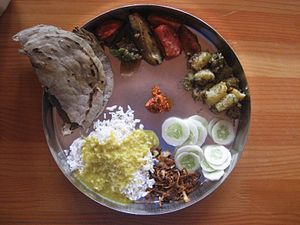
A number of dishes, such as idli, rava idli, Mysore masala dosa, etc., were invented here and have become popular beyond the state of Karnataka. Equally, varieties in the cuisine of Karnataka have similarities with its three neighbouring South Indian states, as well as the states of Maharashtra and Goa to its north. It is very common for the food to be served on a banana leaf, especially during festivals and functions.
Karnataka cuisine can be very broadly divided into Mysore/Bangalore cuisine, North Karnataka cuisine, Udupi cuisine, Kodagu/Coorg cuisine, Karavali/coastal cuisine, and Saraswat cuisine.
This cuisine covers a wide spectrum of food from pure vegetarian and vegan to meats like pork, and from savouries to sweets.
Typical dishes include bisi bele bath, jolada rotti, badanekai yennegai, holige, kadubu, chapati, idli vada, ragi rotti, akki rotti, saaru, huli, kootu, vangibath, khara bath, kesari bhath, sajjige, neer dosa, mysoore, haal bai,chiroti, benne dose, ragi mudde, and uppittu.
The Kodagu district is known for spicy pork curries, while coastal Karnataka specialises in seafood. Although the ingredients differ regionally, a typical Kannadiga oota (Kannadiga meal) is served on a banana leaf. The coastal districts of Dakshina Kannada and Udupi have slightly varying cuisines, which make extensive use of coconut in curries and frequently include seafood.
Kerala

Contemporary Kerala food includes vegetarian and non-vegetarian dishes. Fish and seafood play a major role in Kerala cuisine, as Kerala is a coastal state. An everyday Kerala meal in most households consists of rice with fish curry made of sardines, mackerel, seer fish, king fish, pomfret, prawns, shrimp, sole, anchovy, or parrotfish, (mussels, oysters, crabs, squid, scallops are not rare), and vegetable curry and stir-fried vegetables with or without coconut traditionally known as thoran or mizhukkupiratti. As Kerala has large number of inland water bodies, freshwater fish are also abundant, and part of regular meals. It is common in Kerala to have a breakfast with non-vegetarian dishes in restaurants, in contrast to other states in India. Chicken or mutton stews, lamb, chicken, beef, pork, egg curry, and fish curry with tapioca for breakfast are also widely enjoyed.
Kerala cuisine reflects its rich trading heritage. Over time, various cuisines have blended with indigenous dishes, while foreign ones have been adapted to local tastes. Significant Arab, Syrian, Portuguese, Dutch, Jewish, and Middle Eastern influences exist in this region's cuisine.

Coconuts grow in abundance in Kerala, so grated coconut and coconut milk are commonly used for thickening and flavouring. Having been a major region of spice cultivation and trade for thousands of years, the spices like black pepper, cardamom, clove, ginger, cumin and cinnamon finds extensive use in Kerala cuisine. Kerala sadhya, an elaborate vegetarian banquet prepared for festivals and ceremonies. A full-course sadhya, which consists of rice with about 20 different accompaniments and desserts is the ceremonial meal, eaten usually on celebrations such as marriages, Onam, Vishu, etc. and is served on a plantain leaf.
Most of Kerala's Hindus, except its Brahmin community, eats fish, chicken, beef, pork, eggs, and mutton. The Brahmin are famed for their vegan cuisine, especially varieties of sambar and rasam. A thick vegetable stew popular in South and Central India called avial is believed to have originated in southern Kerala. The avial, eaten widely in the state, is an important vegetarian dish in Kerala sadya. In most Kerala households, a typical meal consists of rice served along with vegetables and fish or meat dishes. Kerala also has a variety of breakfast dishes like idli, dosa, appam, idiyappam, puttu, parotta and pathiri served with sambar, coconut chutney, mutta curry (egg curry), kadala (chickpea) curry, green peas, chicken curry, beef curry and mutton curry.
The Muslim community of Kerala blend Arabian, North Indian, and indigenous Malabari cuisines, using chicken, eggs, beef, and mutton. Thalassery biryani is the only biryani variant, which is of Kerala origin having originated in Talassery, in Malabar region. The dish is significantly different from other biryani variants. Snacks like Pazham nirachathu, Unnakkai, Bread pola— made of bread, eggs, milk and a simple masala, Iftar preparations like Thari kanji, Kozhi pichuporichathu (shredded chicken), Pidi— a preparation of rice dumplings dunked in gravy,Irachi pathiri, Chatti pathiri, Meen pathiri, Neriya pathiri and Kannu vecha pathiri — roti varieties usually made of powdered rice, dishes like Kaai curry etc., are also contributions of Muslim community to the broad Kerala cuisine. The Pathanamthitta region is known for raalan and fish curries. Appam along with wine and curries of duck, pork and cured beef are popular among Syrian Christians in Central Kerala.
Popular desserts are payasam (pudding) and halwa. Payasam, especially Ambalappuzha Paalpayasam also known as Gopala Kashayam (Krishnan's potion) prepared at the 17th century Ambalappuzha Sri Krishna swami temple, is a delicacy known for its unique and flavourful taste. Interestingly, on each day the paalpayasam is prepared only after (ritualistically) seeking due permission from the presiding deity — Shri Krishna. Kerala has a number of paayasam varieties including but not limited to Paalpayasam, Vermicelli Payasam, Pradhaman, Ada Pradhaman, Chakka (Jackfruit) Pradhaman, Parippu Paayasam and more. Paayasam like Vermicelli Payasam (Semiya payasam) also finds a place in Iftar feast of Muslim communities in Kerala.
Halva is one of the most commonly found or easily recognized sweets in bakeries throughout Kerala, and originated from the Gujarathi community in Calicut. Europeans used to call the dish "sweetmeat" due to its texture, and a street in Kozhikode where became named Sweet Meat Street during colonial rule. This is mostly made from maida (highly refined wheat), and comes in various flavours, such as banana, ghee or coconut. However, karutha haluva (black haluva) made from rice is also very popular.
Ladakh

Ladakhi cuisine is from the two districts of Leh and Kargil in the union territory of Ladakh. Ladakhi food has much in common with Tibetan food, the most prominent foods being thukpa (noodle soup) and tsampa, known in Ladakhi as ngampe (roasted barley flour). Edible without cooking, tsampa makes useful trekking food.
Strictly Ladakhi dishes include skyu and chutagi, both heavy and rich soup pasta dishes, skyu being made with root vegetables and meat, and chutagi with leafy greens and vegetables. As Ladakh moves toward a cash-based economy, foods from the plains of India are becoming more common.
As in other parts of Central Asia, tea in Ladakh is traditionally made with strong green tea, butter, and salt. It is mixed in a large churn and known as gurgur cha, after the sound it makes when mixed. Sweet tea (cha ngarmo) is common now, made in the Indian style with milk and sugar. Most of the surplus barley that is produced is fermented into chang, an alcoholic beverage drunk especially on festive occasions.
Lakshadweep
The cuisine of Lakshadweep prominently features seafood and coconut. Local food consists of spicy non-vegetarian and vegetarian dishes.
The culinary influence of Kerala is quite evident in the cuisines of Lakshadweep, since the island lies in close proximity to Kerala. Coconut and sea fish serve as the foundation of most meals.
The people of Lakshadweep drink large amounts of coconut water, which is the most abundant aerated drink on the island. Coconut milk is the base for most of the curries. All the sweet or savory dishes have a touch of famous Malabar spices. Local people also prefer to have dosa, idlis, and various rice dishes.
Madhya Pradesh

The cuisine in Madhya Pradesh varies regionally. Wheat and meat are common in the north and west of the state, while the wetter south and east are dominated by rice and fish. Milk is a common ingredient in Gwalior and Indore.
The street food of Indore is well known, with shops that have been active for generations. Bhopal is known for meat and fish dishes such as rogan josh, korma, qeema, biryani, pilaf, and kebabs. On a street named Chatori Gali in old Bhopal, one can find traditional Muslim nonvegetarian fare such as paya soup, bun kabab, and nalli-nihari as some of the specialties.
Dal bafla is a common meal in the region and can be easily found in Indore and other nearby regions, consisting of a steamed and grilled wheat cake dunked in rich ghee, which is eaten with daal and ladoos.
The culinary specialty of the Malwa and Indore regions of central Madhya Pradesh is poha (flattened rice); usually eaten at breakfast with jalebi.
Beverages in the region include lassi, beer, rum and sugarcane juice. A local liquor is distilled from the flowers of the mahua tree. Date palm toddy is also popular. In tribal regions, a popular drink is the sap of the sulfi tree, which may be alcoholic if it has fermented.
Maharashtra

Maharashtrian cuisine is an extensive balance of many different tastes. It includes a range of dishes from mild to very spicy tastes. Bajri, wheat, rice, jowar, vegetables, lentils, and fruit form important components of the Maharashtrian diet.
Popular dishes include puran poli, ukdiche modak, batata wada, sabudana khichdi, masala bhat, pav bhaji, and wada pav. Poha or flattened rice is also usually eaten at breakfast. Kanda poha and aloo poha are some of the dishes cooked for breakfast and snacking in evenings.

The cuisine of Vidarbha uses groundnuts, poppy seeds, jaggery, wheat, jowar, and bajra extensively. A typical meal consists of rice, roti, poli, or bhakar, along with varan and aamtee—lentils and spiced vegetables. Cooking is common with different types of oil.
Savji food from Vidarbha is well known all over Maharashtra. Savji dishes are very spicy and oily. Savji mutton curries are very famous.
Like other coastal states, an enormous variety of vegetables, fish, and coconuts exists, where they are common ingredients. Peanuts and cashews are often served with vegetables. Grated coconuts are used to flavour many types of dishes, but coconut oil is not widely used; peanut oil is preferred.
Kokum, most commonly served chilled, in an appetiser-digestive called sol kadhi, is prevalent. During summer, Maharashtrians consume panha, a drink made from raw mango.
Malwani

Malwani cuisine is a specialty of the tropical area which spans from the shore of Deogad Malwan to the southern Maharashtrian border with Goa. The unique taste and flavor of Malwani cuisine comes from Malwani masala and use of coconut and kokam.
The staple foods are rice and fish. Various kinds of red and green fish, prawns, crab, and shellfish curries (also called mashacha sar in the Malwani language) are well known, along with kombadi (chicken) wade and mutton prepared Malwani style. Mohari mutton is also one of the distinct delicacies of Malwani cuisine.
A large variety of fish is available in the region, which include surmai, karali, bangada, bombil (Bombay duck), paplet (pomfret), halwa, tarali, suandale, kolambi (prawns), tisari (shellfish), kalwa (stone fish) and kurli (crab).
All these fish are available in dried form, including prawns, which are known as sode. Local curries and chatanis are also prepared with dried fish.
Different types of rice breads and pancakes add to the variety of Malwani cuisine and include tandlachi bhakari, ghawane, amboli, patole, appe, tandalachi and shavai (rice noodles). These rice breads can be eaten specially flavored with coconut milk, fish curries, and chicken or mutton curries.
Sole kadi made from kokam and coconut milk is a signature appetizer drink . For vegetarians, Malwani delicacies include alloochi bhaji, alloochi gathaya, kalaya watanyacha, and sambara (black gram stew).
The sweets and desserts include ukadiche modak, Malawani khaje, khadakahde kundiche ladu, shegdanyache ladu, tandalchi kheer, and tandalachi shavai ani ras (specially flavored with coconut milk).
Manipur
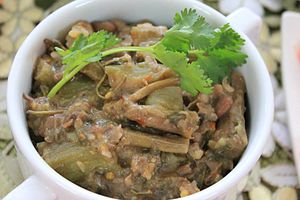
Manipuri cuisine is represented by the cuisine of the Meitei people who form the majority population in the central plain. Meitei food are simple, tasty, organic and healthy. Rice with local seasonal vegetables and fish form the main diet.
Most of the dishes are cooked like vegetable stew, flavored with either fermented fish called ngari, or dried and smoked fish.
The most popular Manipuri dish is eromba, a preparation of boiled and mashed vegetables, often including carrots, potatoes or beans, mixed with chilli and roasted fermented fish.
Another popular dish is the savory cake called paknam, made of a lentil flour stuffed with various ingredients such as banana inflorescence, mushrooms, fish, vegetables etc., and baked covered in turmeric leaves.
Along with spicy dishes, a mild side dish of steamed or boiled sweet vegetables are often served in the daily meals. The Manipuri salad dish called singju, made of finely julienned cabbage, green papaya, and other vegetables, and garnished with local herbs, toasted sesame powder and lentil flour is extremely popular locally, and often found sold in small street side vendors.
Singju is often served with bora, which are fritters of various kinds, and also kanghou, or oil-fried spicy veggies. Cooked and fermented soybean is a popular condiment in all Manipuri kitchens.
The staple diet of Manipur consists of rice, fish, large varieties of leafy vegetables (of both aquatic and terrestrial). Manipuris typically raise vegetables in a kitchen garden and rear fishes in small ponds around their house. Since the vegetables are either grown at home or obtained from local market, the cuisines are very seasonal, each season having its own special vegetables and preparations.
The taste is very different from mainland Indian cuisines because of the use of various aromatic herbs and roots that are peculiar to the region. They are however very similar to the cuisines of Southeast, East, and Central Asia, Siberia, Micronesia and Polynesia.
Meghalaya

Meghalayan cuisine is unique and different from other Northeastern Indian states. Spiced meat is common, from goats, pigs, fowl, ducks, chickens, and cows. In the Khasi and Jaintia Hills districts, common foods include jadoh, ki kpu, tung-rymbai, and pickled bamboo shoots.
Other common foods in Meghalaya include minil songa (steamed sticky rice), sakkin gata, and momo dumplings.
Like other tribes in the northeast, the Garos ferment rice beer, which they consume in religious rites and secular celebrations.
Mizoram
The cuisine of Mizoram differs from that of most of India, though it shares characteristics to other regions of Northeast India and North India.
Rice is the staple food of Mizoram, while Mizos love to add non-vegetarian ingredients in every dish. Fish, chicken, pork and beef are popular meats among Mizos. Dishes are served on fresh banana leaves. Most of the dishes are cooked in mustard oil.
Meals tend to be less spicy than in most of India. Mizos love eating boiled vegetables along with rice. A popular dish is bai, made from boiling vegetables (spinach, eggplant, beans, and other leafy vegetables) with bekang (fermented soya beans) or sa-um, fermented pork fat served with rice. Sawhchiar is another common dish, made of rice and cooked with pork or chicken.
Nagaland

The cuisine of Nagaland reflects that of the Naga people. It is known for exotic pork meats cooked with simple and flavourful ingredients, like the extremely hot bhut jolokia (ghost chili) pepper, fermented bamboo shoots, and akhuni ( fermented soya beans). Another unique and strong ingredient used by the Naga people, is the fermented fish known as ngari.
Fresh herbs and other local greens also feature prominently in the Naga cuisine. The Naga use oil sparingly, preferring to ferment, dry, and smoke their meats and fish.
Traditional homes in Nagaland have external kitchens that serve as smokehouses.
A typical meal consists of rice, meat, a chutney, a couple of stewed or steamed vegetable dishes, flavored with ngari or akhuni. Desserts usually consist of fresh fruits.
Odisha

The cuisine of Odisha relies heavily on local ingredients. Flavours are usually subtle and delicately spiced. Fish and other seafood, such as crab and shrimp, are very popular, and chicken and mutton are also consumed.
Panch phutana, a mix of cumin, mustard, fennel, fenugreek and kalonji (nigella), is widely used for flavouring vegetables and dals, while garam masala and turmeric are commonly used for meat-based curries.
Pakhala, a dish made of rice, water, and dahi (yogurt), that is fermented overnight, is very popular in summer in rural areas. Oriyas are very fond of sweets, so dessert follows most meals.
Popular Oriya dishes include anna, kanika, dalma, khata (tamato and oou), dali (different types of lentils, i.e. harada [red gram], muga [green gram], kolatha [horsegram], etc.), spinach and other green leaves, and alu-bharta (mashed potato) along with pakhala.
Odisha and neighboring West Bengal both claim to be the origin of rasgulla, each state having a geographical indication for their regional variety of the dessert. Odisha is also known for its chhena-based sweets, including chhena poda, chhena gaja, chhena jhili, and rasabali.
Puducherry
The union territory of Puducherry was a French colony for around 200 years, making French cuisine a strong influence on the area. Tamil cuisine is eaten by the territory's Tamil majority. The influence of the neighbouring areas, such as Andhra Pradesh and Kerala, is also visible on the territory's cuisine.
Some favourite dishes include coconut curry, tandoori potato, soya dosa, podanlangkai (snake gourd chutney), curried vegetables, stuffed cabbage, and baked beans.
Punjab

The cuisine of Punjab is known for its diverse range of dishes. It is closely related to the cuisine of the neighbouring Punjab province of Pakistan.
The state, being an agriculture center, is abundant with whole grains, vegetables, and fruits. Home-cooked and restaurant Punjabi cuisine can vary significantly.
Restaurant-style Punjabi cooking puts emphasis on creamy textured foods by using ghee, butter and cream, while home-cooked meals center around whole wheat, rice, and other ingredients flavored with various kinds of masalas.
Common dishes cooked at home are roti with daal and dahi (yogurt) with a side chutney and salad that includes raw onion, tomato, cucumber, etc.
The meals are also abundant of local and seasonal vegetables usually sautéed with spices such as cumin, dried coriander, red chili powder, turmeric, black cloves, etc. Masala chai is a favorite drink and is consumed in everyday life and at special occasions.
Many regional differences exist in the Punjabi cuisine based on traditional variations in cooking similar dishes, food combinations, preference of spice combination, etc. It is clear that "the food is simple, robust, and closely linked to the land."
Certain dishes exclusive to Punjab, such as makki di roti and sarson da saag, dal makhani, and others are a favorite of many.
The masala in a Punjabi dish traditionally consists of onion, garlic, ginger, cumin, garam masala, salt, turmeric, tomatoes sauteed in mustard oil. Tandoori food is a Punjabi specialty. Dishes like Bhatti da murgh also known as tandoori chicken, Chicken hariyali kabab, Achari paneer tikka, fish ajwaini tikka and Amritsari kulcha are some popular tandoori foods from Punjab.

Common meat dishes in this region are Bhakra curry (goat) and fish dishes. Dairy products are regularly enjoyed and usually accompany main meals in the form of dahi, milk, and milk-derived products such as lassi, paneer, and more.
Punjab has a large number of people following the Sikh religion who traditionally follow a vegetarian diet (which includes plant-derived foods, milk, and milk by-products. See diet in Sikhism) in accordance to their beliefs.
No description of Punjabi cuisine is complete without the myriad of famous desserts, such as kheer, gajar ka halwa, sooji (cream of wheat) halwa, rasmalai, gulab jamun and jalebi. Most desserts are ghee or dairy-based, use nuts such as almonds, walnuts, pistachios, cashews, and, raisins.
Many of the most popular elements of Anglo-Indian cuisine, such as tandoori foods, naan, pakoras and vegetable dishes with paneer, are derived from Punjabi styles.
Punjabi food is well liked in the world for its flavors, spices, and, versatile use of produce, and so it is one of the most popular cuisines from the sub-continent. Last but not least are the chhole bhature and chhole kulche> which are famous all over the North India.
Cooking in Rajasthan, an arid region, has been strongly shaped by the availability of ingredients. Food is generally cooked in milk or ghee, making it quite rich. Gram flour is a mainstay of Marwari food mainly due to the scarcity of vegetables in the area.
Historically, food that could last for several days and be eaten without heating was preferred. Major dishes of a Rajasthani meal may include daal-baati, tarfini, raabdi, ghevar, bail-gatte, panchkoota, chaavadi, laapsi, kadhi and boondi. Typical snacks include bikaneri bhujia, mirchi bada, pyaaj kachori, and dal kachori.
Daal-baati is the most popular dish prepared in the state. It is usually supplemented with choorma, a mixture of finely ground baked rotis, sugar and ghee.
Rajasthan is also influenced by the Rajput community who have liking for meat dishes. Their diet consisted of game meat and gave birth to dishes like laal maans, safed maas,
In Sikkim, various ethnic groups such as the Nepalese, Bhutias, and Lepchas have their own distinct cuisines. Nepalese cuisine is very popular in this area.
Rice is the staple food of the area, and meat and dairy products are also widely consumed. For centuries, traditional fermented foods and beverages have constituted about 20 percent of the local diet.
Depending on altitudinal variation, finger millet, wheat, buckwheat, barley, vegetables, potatoes, and soybeans are grown. Dhindo, daal bhat, gundruk, momo, gya thuk, ningro, phagshapa, and sel roti are some of the local dishes.
Alcoholic drinks are consumed by both men and women. Beef is eaten by Bhutias.
Sindhi cuisine refers to the native cuisine of the Sindhi people from the Sindh region, now in Pakistan. While Sindh is not geographically a part of modern India, its culinary traditions persist, due to the sizeable number of Hindu Sindhis who migrated to India following the independence of Pakistan in 1947, especially in Sindhi enclaves such as Ulhasnagar and Gandhidam.
A typical meal in many Sindhi households includes wheat-based flatbread (phulka) and rice accompanied by two dishes, one with gravy and one dry. Lotus stem (known as kamal kakri) is also used in Sindhi dishes. Cooking vegetables by deep frying is common.
Some regular Sindhi dishes are sindhi kadhi, sai bhaji, koki and besan bhaji. Ingredients frequently used are mango powder, tamarind, kokum flowers, and dried pomegranate seeds.
Tamil Nadu

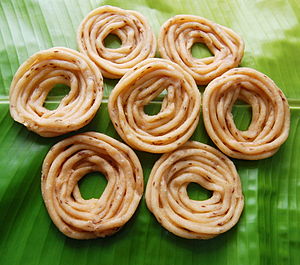
Tamil Nadu is noted for its deep belief that serving food to others is a service to humanity, as is common in many regions of India. The region has a rich cuisine involving both traditional non-vegetarian and vegetarian dishes.
Tamil food is characterised by its use of rice, legumes, and lentils, along with distinct aromas and flavours achieved by the blending of spices such as mustard, curry leaves, tamarind, coriander, ginger, garlic, chili pepper, cinnamon, clove, cardamom, cumin, nutmeg, coconut and rose water.
The traditional way of eating involves being seated on the floor, having the food served on a plantain leaf, and using the right hand to eat. After the meal the plantain leaf is discarded but becomes food for free-ranging cattle and goats.
A meal (called saapadu) consists of rice with other typical Tamil dishes on a plantain leaf. A typical Tamilian would eat on a plantain leaf as it is believed to give a different flavour and taste to food. Also growing in popularity are stainless-steel trays, plates with a selection of different dishes in small bowls.
Tamil food is characterized by tiffin, which is a light food taken for breakfast or dinner, and meals which are usually taken during lunch. The word "curry" is derived from the Tamil kari, meaning something similar to "sauce".
Southern regions such as Tirunelveli, Madurai, Paramakudi, Karaikudi, Chettinad and Kongu Nadu are noted for their spicy non-vegetarian dishes. Dosa, idli, pongal and biryani are some of the popular dishes that are eaten with chutney and sambar. Fish and other seafoods are also very popular, because the state is located on the coast. Chicken and goat meat are the predominantly consumed meats in Tamil Nadu.
A typical Tamil vegetarian meal is heavily dependent on rice, vegetables and lentil preparations such as rasam and sambar, but there are variations. They have influenced Kerala as well in their kootu, arachi vitta sambhar and molagootals (mulligatawny soup).
As mentioned above, the Chettinad variety of food uses many strong spices, such as pepper, garlic, fennel seeds and onions. Tamil food tends to be spicy compared to other parts of India so there is a tradition of finishing the meal with dahi (yogurt) is considered a soothing end to the meal.
Notably, Tamil Brahmin cuisine, the food of the Iyers and Iyengar community, is characterized by slightly different meal times and meal structures compared to other communities within the state.
Historically vegetarian, the cuisine is known for its milder flavor and avoidance of onion and garlic (although this practice appears to be disappearing with time).
After a light morning meal of filter coffee and different varieties of porridges (oatmeal and janata kanji are immensely popular), the main meal of the day, lunch/brunch is usually at 11 am and typically follows a two-three course meal structure. Steamed rice is the main dish, and is always accompanied by a seasonally steamed/sauteed vegetable (poriyal), and two or three types of tamarind stews, the most popular being sambhar and rasam. The meal typically ends with thair sadham (rice with yogurt), usually served with pickled mangoes or lemons.
Tiffin is the second meal of the day and features several breakfast favorites such as idli, rava idli, upma, dosa varieties, and vada, and is usually accompanied by chai.
Dinner is the simplest meal of the day, typically involving leftovers from either lunch or tiffin. Fresh seasonal fruit consumed in the state include bananas, papaya, honeydew and canteloupe melons, jackfruit, mangos, apples, kasturi oranges, pomegranates, and nongu (hearts of palm).
Telangana

The cuisine of Telangana consists of the Telugu cuisine, of Telangana's Telugu people as well as Hyderabadi cuisine (also known as Nizami cuisine), of Telangana's Hyderabadi Muslim community.
Hyderabadi food is based heavily on non-vegetarian ingredients, while Telugu food is a mix of both vegetarian and non-vegetarian ingredients. Telugu food is rich in spices and chillies are abundantly used. The food also generally tends to be more on the tangy side with tamarind and lime juice both used liberally as souring agents.
Rice is the staple food of Telugu people. Starch is consumed with a variety of curries and lentil soups or broths. Vegetarian and non-vegetarian foods are both popular.
Hyderabadi cuisine includes popular delicacies such as biryani, haleem, Baghara baingan and kheema, while Hyderabadi day-to-day dishes see some similarities to Telanganite Telugu food, with its use of tamarind, rice, and lentils, along with meat.
Tripura

The Tripuri people are the original inhabitants of the state of Tripura in northeast India. Today, they comprise the communities of Tipra, Reang, Jamatia, Noatia, and Uchoi, among others. The Tripuri are non-vegetarian, although they have a minority of Vaishnavite vegetarians.
The major ingredients of Tripuri cuisine include vegetables, herbs, pork, chicken, mutton, fishes, turtle, shrimps, crabs, freshwater mussels, periwinkles, edible freshwater snails and frogs.
Traditionally, Uttar Pradeshi cuisine consists of Awadhi, Bhojpuri, and Mughlai cuisine, though a vast majority of the state is vegetarian, preferring dal, roti, sabzi, and rice. Pooris and kachoris are eaten on special occasions.
Well-known dishes include kebabs, dum biryani, and various mutton recipes. Sheer qorma, ghevar, gulab jamun, kheer, and ras malai are some of the popular desserts in this region.
Awadhi cuisine (Hindi: अवधी खाना) is from the city of Lucknow, which is the capital of the state of Uttar Pradesh in Central-South Asia and Northern India, and the cooking patterns of the city are similar to those of Central Asia, the Middle East, and other parts of Northern India. The cuisine consists of both vegetarian and non-vegetarian dishes.
Awadh has been greatly influenced by Mughal cooking techniques, and the cuisine of Lucknow bears similarities to those of Central Asia, Kashmir, Punjab and Hyderabad. The city is also known for its Nawabi foods. The bawarchis and rakabdars of Awadh gave birth to the dum style of cooking or the art of cooking over a slow fire, which has become synonymous with Lucknow today. Their spread consisted of elaborate dishes like kebabs, kormas, biryani, kaliya, nahari-kulchas, zarda, sheermal, roomali rotis, and warqi parathas.
The richness of Awadh cuisine lies not only in the variety of cuisine but also in the ingredients used like mutton, paneer, and rich spices, including cardamom and saffron.
Mughlai cuisine is a style of cooking developed in the Indian subcontinent by the imperial kitchens of the Mughal Empire. It represents the cooking styles used in North India (especially Uttar Pradesh).
The cuisine is strongly influenced by Central Asian cuisine, the region where the Chagatai-Turkic Mughal rulers originally hailed from, and has strongly influenced the regional cuisines of Kashmir and the Punjab region.
The tastes of Mughlai cuisine vary from extremely mild to spicy, and is often associated with a distinctive aroma and the taste of ground and whole spices.
A Mughlai course is an elaborate buffet of main course dishes with a variety of accompaniments.
Uttarakhand

Food from Uttrakhand is known to be healthy and wholesome to suit the high-energy necessities of the cold, mountainous region. It is a high-protein diet that makes heavy use of pulses and vegetables. Traditionally, it is cooked over wood or charcoal fire mostly using iron utensils.
While making use of condiments such as jeera, haldi and rai common in other Indian cuisines, Uttarakhand cuisine also use exotic ingredients such as jambu, timmer, ghandhraini and bhangira.
Although the people in Uttarakhand also make dishes common in other parts of northern India, several preparations are unique to Uttarakhand such as rus, chudkani, dubuk, chadanji, jholi, kapa, and more.
Among dressed salads and sauces, kheere ka raita, nimbu mooli ka raita, daarim ki khatai and aam ka fajitha are also popular.
The cuisine mainly consists of food from two different sub-regions, Garhwal and Kumaon, though their basic ingredients are the same. Both Kumaoni and Garhwali styles make liberal use of ghee, lentils or pulses, vegetables and bhaat (rice). They also use badi (sun-dried urad dal balls) and mungodi (sun-dried moong dal balls) as substitutes for vegetables at times.
During festivals and other celebrations, the people of Uttarakhand prepare special refreshments which include both salty preparations such as bada and sweet preparations such as pua and singal. Uttarakhand also has several sweets (mithai) such as singodi, bal-mithai, and malai laddu, native to its traditions.
ギャラリー
- 北インド
- 西インド
-
Locho/jaローチョとイダダ
-
Chhole Upma
-
タンドーリ・レモンフィッシュ・フライ
- 東インド
-
プランテイン・ダンプリングス
-
ルチ・アル・トルカリ
-
竹蒸米
-
Tamul Paan
-
プラサド・ターリ
-
Tan Ngang
- 南インド
-
Khotto
-
プラウン・ビリヤニ
ヒンドゥー教の断食料理

ヒンドゥー教徒は、ヴィシュヌ神またはその化身を称えるEkadashi、ガネーシャ神を称えるChaturthi、シヴァ神を称える月曜日、ハヌマーン神または土星を称える土曜日などの日に断食をする。
特定の種類の食品のみが食べることが許されている。これらには、牛乳やその他の乳製品(ダヒー'など)、果物、および sago、ジャガイモ、紫赤色のサツマイモ、アマラスの種、ナッツ、ヒエなどの西洋の食品が含まれる。
人気のある断食料理には、ファラーリ・チェヴド、サグダナ・キチュディ、ピーナッツスープなどがある。
ディアスポラとフュージョン料理
様々なインド人ディアスポラのコミュニティが、新たな故郷の土着文化と交流することで、インド料理と他の国際的な料理の側面を融合させた多くのフュージョン料理が生まれた。これらの料理は、インドの調味料と調理技術を自国の料理に取り入れる傾向がある。
インド中華料理

インド中華料理は、インド・中国料理とも呼ばれ、19世紀にコルカタの中国人コミュニティの間で生まれた。これは、第一次および第二次アヘン戦争と地域の政治的不安定から逃れるために広州(現在の広州市)から客家が移住したことに始まる。現地のインド料理に触れると、彼らは多くのスパイスと調理技術を自身の料理に取り入れ、インド料理と中華料理のユニークな融合を生み出した。
1947年以降、多くの広東人移民がコルカタに自身のレストランを開き、その料理はインド料理と広東料理の側面を組み合わせたものであった。インドの他の地域では、インド中華料理はコルカタ-中華料理に由来するが、料理にはクミン、コリアンダーの種子、ターメリックで風味付けされる傾向があり、いくつかの地域的な例外を除いて、伝統的に中華料理とは関連付けられていないため、中国の料理とはほとんど似ていない。チリ、生姜、ニンニク、そしてダヒー'(ヨーグルト)も料理によく使われる。
人気のある料理には、チキンマンチュリアン、チキンロリポップ、チリチキン、客家麺、湖南チキン、チャウメン、四川チャーハンなどがある。
マンチャウスープやスイートコーンスープなどのスープは非常に人気があり、デザートにはハチミツ揚げ麺にアイスクリームを添えたものや、ナツメヤシのパンケーキなどがある。
チャウメンは現在、インドで最も人気のある中華料理の1つとして知られている。特に西ベンガル州では、最も愛されているストリートフードの1つである。
インド・タイ料理
タイ料理は、タイの僧侶であるBuddhadasa Bhikkuが著書『タイへのインドの恩恵』で記録しているように、インド料理から影響を受けた。彼は、タイ人が様々な方法でインド人から料理にスパイスを使う方法を学んだと書いている。タイ人はまた、インド人から薬草(アーユルヴェーダ)の作り方も学んだ。フクギ科のサラビ、ハルシンガルまたはカニカ、ピクン、テツボクまたはブンナクなどのいくつかの植物がインドから持ち込まれた。
マレーシア・インド料理
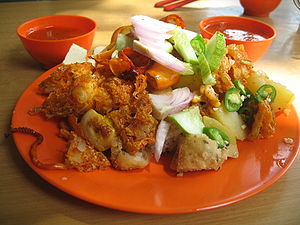
マレーシア・インド料理、またはマレーシアのインド系民族コミュニティの料理は、インドの本格的な料理の適応と、マレーシアの多様な食文化に触発されたオリジナルの創作料理で構成されている。
典型的なマレーシア・インド料理は、カレーリーフ、ホールスパイスと粉末スパイスがふんだんに使われ、様々な形で新鮮なココナッツが含まれていることが多い。
ギーは依然として調理に広く使用されているが、植物油と精製されたパーム油も家庭の台所で一般的になっている。
シンガポール・インド料理
シンガポール・インド料理とは、南アジアの食文化に全体または一部に由来する、シンガポールで生産および消費される食品および飲料を指す。
シンガポール料理の多様性にはインド料理が含まれており、それはタミル料理、特に地元のタミル・ムスリム料理である傾向があるが、近年では北インド料理もより目立つようになっている。
インド料理は、長年の他のシンガポール文化との接触や、地元で入手可能な食材への対応、変化する地元の嗜好に応じて、さまざまな程度に修正されてきた。
インド・インドネシア料理

インドネシア・インド料理とは、インドネシア料理においてインド料理、特にタミル料理、パンジャブ料理、グジャラート料理から影響を受けた食品および飲料を指す。これらの料理は、アッパム、ビリヤニ、ムルタバ、カレーなど、よく統合されている。
インド・フィリピン料理
フィリピン諸島全体に見られるフィリピン料理は、歴史的にインド料理の影響を受けてきた。インドの影響は、bibingka(インドネシアの ビンカ に類似)、プト、puto bumbong などの米をベースにした珍味にも見られ、後者2つは、南インド料理の プトゥ に由来する可能性が高く、これも東南アジアの島嶼部全体(例:kue putu、putu mangkok)にバリエーションがある。
一方、ルソン島でより人気のある カレカレ は、七年戦争の際、イギリスがマニラを占領した1762年から1764年までの期間に、インドのセポイを含む軍隊がフィリピンでカレーを作るためのスパイス不足のため、インド料理を即席で作らざるを得なかったことに起源を辿ることができる。これが、その名前と、カレーの一種を連想させる、濃厚で黄色からオレンジ色のベニノキとピーナッツベースのソースの説明であると言われている。
フィリピンのアチャラは、インドの アチャール に由来し、インドネシア、マレーシア、ブルネイのアチャールを介してフィリピンに伝わった。
アングロ・インド料理
アングロ・インド料理は、インドにおけるイギリスの植民地支配の時代に、イギリスの官僚がインド人の料理人と交流する中で発展した。
よく知られたアングロ・インド料理には、チャツネ、塩漬け牛タン、ケジュリー、ボールカレー、魚のリゾール、ムルガタウニースープなどがある。
デザート
多くのインドのデザート、または ミターイー は、砂糖、牛乳、またはコンデンスミルクで作られた揚げ物である。材料と好まれるデザートの種類は地域によって異なる。例えば、インド東部では、ほとんどが乳製品をベースにしている。
多くはアーモンドとピスタチオで風味付けされ、カルダモン、ナツメグ、クローブ、黒コショウでスパイスが加えられ、ナッツ、または金箔や銀箔で飾られている。人気のあるインドのデザートには、rasogolla、gulab jamun、jalebi、laddu/jaladdu、そして peda などがある。
飲料
ノンアルコール飲料
茶はインド全土で主要な飲料であり、同国は世界最大の茶生産国の1つである。インドで栽培されている最も人気のある茶の種類には、アッサム茶、ダージリン茶、ニルギリ茶などがある。水、牛乳、およびカルダモン、クローブ、シナモン、生姜などのスパイスの混合物で茶葉を煮沸して作られる。インドでは、茶はしばしばビスケットや パコラ などの軽食と共に楽しまれる。
コーヒーも人気のある飲料であるが、南インドでより人気がある。コーヒーはインドの一部でも栽培されている。インドで人気のあるコーヒーには、インド式フィルターコーヒーとインスタントコーヒーの2種類がある。
ラッシー は、インドの伝統的なダヒー'(ヨーグルト)ベースの飲み物である。ヨーグルトを水または牛乳とスパイスで混ぜて作られる。塩味の ラッシー は、パンジャブの村とポルバンダル(グジャラート州)でより一般的である。伝統的な ラッシー は、挽いたローストクミンで風味付けされることもある。ラッシー は、砂糖、ローズウォーター、マンゴー、レモン、イチゴ、サフランなどの材料で風味付けすることもできる。
シャハバート は、果物または花びらから作られた甘い冷たい飲み物である。濃縮された形で提供され、スプーンで食べたり、水で希釈して飲み物として飲んだりできる。人気のある シャルバート は、バラ、白檀、ベル、グルハル(ハイビスカス)、レモン、オレンジ、パイナップル、サラサパリラ'、コクム、ファルサ(Grewia asiatica)などの植物から作られる。アーユルヴェーダでは、シャルバート は薬効があると信じられている。
タンダイ は、アーモンド、フェンネルの種、スイカの種、バラの花びら、コショウ、ケシの実、カルダモン、サフラン、牛乳、砂糖の混合物で作られた冷たい飲み物である。インド原産であり、しばしばマハー・シヴァラトリとホーリー祭またはホラ・モハッラ祭に関連付けられている。時々、特別なタンダイを作るために |バーング(大麻)が加えられる。
その他の飲料には、ニムブー・パニ(レモネード)、chaas、badam doodh(ナッツとカルダモン入りのアーモンドミルク)、Aam panna、kokum sharbat、ココナッツウォーターなどがある。
南インド特有の現代的な炭酸入り冷たい飲み物には、炭酸水、ローズウォーター、ローズミルク、砂糖の混合物である パナーソーダ または ゴリソーダ、炭酸水、塩、レモンジュースの混合物である ナランガソーダ、サラサパリラ'を含む混合物である ナンナリサルバット などがある。
炭酸水入りの シャルバート は、ケララ州とタミル・ナードゥ州で最も人気のあるノンアルコール飲料である。ケララ州中央部とタミル・ナードゥ州マドゥライ地域の露店は、これらの飲み物でよく知られており、ケララ州では クルッキ・シャルバット とも呼ばれている。
-
多様なダージリン茶
-
南インドで人気のインド式フィルターコーヒー
-
バダーム'ミルク
-
ホーリー祭スペシャル 冷やしたタンダイ
アルコール飲料
ビール

インドのほとんどのビールは、ラガー(アルコール度数4.8パーセント)またはストロングラガー(8.9パーセント)である。インドのビール産業は、過去10年間で年間10〜17パーセントの安定した成長を遂げている。2008〜2009会計年度の生産量は1億7000万ケースを超えた。人口の平均年齢が低下し、所得水準が上昇するにつれて、国内でのビールの人気は高まり続けている。
その他

インドで人気の他のアルコール飲料には、ココナッツまたはカシューアップルの果汁から作られたゴアの酒である フェニー がある。ゴア州は、その フェニー 蒸留所が「フェニー」という名前で酒類の独占的な製造権を主張できるように、地理的表示を登録している。
ハディア は米ビールで、ハーブと炊いた米を混ぜ合わせ、約1週間発酵させて作られる。冷やして供され、他のインドの酒類よりもアルコール度数が低い。Chuak はトリプラ州の同様の飲み物である。
パームワインは、地元では neera として知られ、様々な種類のトウダイグサヤシの花序から採取される樹液である。
Chhaang は、シッキム州と西ベンガル州のダージリン・ヒマラヤ山岳地帯の人々によって飲まれている。夏は冷やして、または室温で、寒い時期にはしばしば熱くして飲まれる。Chhaang は、大麦、キビ、または米から醸造された伝統的なビールに似ている。
カルU(Kallu)(チェットゥ・カル)は、ケララ州のココナッツと松の木から抽出される人気のある天然のアルコールである。地元の カル ショップで販売され、揚げた魚や鶏肉と一緒に消費される。そのアルコール含有量は、蒸留されたアルコールの添加によって増加する。
食習慣

インド人は健康的な朝食を重要視する。一般的に朝食には紅茶またはコーヒーを好んで飲むが、食べ物の好みは地域によって異なる。北インドの人々は ロティ、パラタ、そして アチャール(漬物)とヨーグルトを添えた野菜料理を好む。様々な種類の包装された漬物が市場で入手可能である。インドで最も古い漬物製造会社の1つは、1860年代にオールドデリーで創業したHarnarainsである。
グジャラートの人々は ドグラ と牛乳を好み、南インドの人々は一般的に サンバル(sambhar) または サグ(sagu) と様々な チャトニ を添えた イドーリ(idli) と ドーサ(dosa) を好む。
インドの伝統的な昼食は通常、南部と東部では米、北部では全粒粉の ロティ(rotis) を主食とする。典型的には2、3種類の野菜と、時には クルチャ、ナーン、または パラタ のような品が含まれる。消化を助ける パーン(詰め物をし、スパイスを加え、折り畳んだビンロウの葉)は、インドの多くの地域で昼食と夕食後にしばしば食べられる。
インドの家庭では、ティータイムと同様に、「夕方の軽食の時間」に集まって会話をし、お茶と軽食をとることが多い。
夕食は一日の主要な食事と考えられている。また、多くの家庭、特に北インドと中央インドでは、夕食後に甘いもの(西洋の食後のデザートの概念と同様)を好む。
食習慣
インドでは、人々はしばしば自身の宗教的信念に基づいて食習慣に従う。
- インドのヒンドゥー教徒のコミュニティの中には、ヒンドゥー教の聖典が牛の屠殺を非難していると信じられているため、牛肉をタブー視する者もいる。インドの多くの州で牛の屠殺は禁止されている。しかし、これらの制限は北東部諸州、西ベンガル州、ケーララ州では守られていない。
- アヒンサー(非暴力)を重視するため、ヴィシュヌ派の信者は一般的に厳格なラクト・ベジタリアンである。彼らはニンニクと玉ねぎも摂取しない。
- ジャイナ教徒は、完全にラクト・ベジタリアンであることに加えて、ニンジンやジャガイモのようなすべての根菜も排除するジャイナ教の菜食主義として知られる厳格なラクト・ベジタリアンの形態に従う。なぜなら、根を引き抜くと、その周りに生息する生物も死ぬからである。
- イスラム教徒は豚肉や豚肉製品を食べない。
特定の北東部地域を除いて、犬は食用に適しているとは考えられていない。
作法
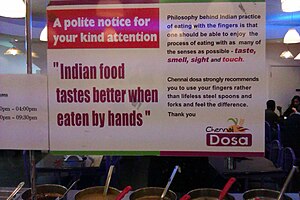
伝統的に、インドでの食事は床、または非常に低い腰掛けやマットレスに座って行われる。食べ物は、ナイフやフォークなどの食器ではなく、手で食べられることが多い。
しばしば ロティ は、カレーが手に触れないように掬うために使われる。小麦の生産が盛んな北部では、ロティの一部を親指と中指で掴み、人差し指でロティを押さえながら引きちぎる
南部では、ドーサ、アダイ(adai)、ウッタパム に対してやや異なる方法が用いられ、中指でパンを押さえ、人差し指と親指で小さな部分を掴んで分離させる。伝統的な給仕のスタイルは、インド全土で地域によって異なる。
他の文化との接触は、インドの食事作法に影響を与えてきた。例えば、アングロ・インディアンの中流階級は、西洋文化で伝統的なように、スプーンやフォークを一般的に使用する。
南インドでは、食事後に処分できる清潔なバナナの葉が料理を盛り付けるために使用される。熱い料理がバナナの葉に盛られると、葉は独特の香りと風味を料理に加える。葉の皿は今日では、特別な機会を除いてあまり一般的ではない。
インド国外

インド人の移住は、亜大陸の食文化を世界中に広めた。これらの料理は現地の嗜好に合わせられ、また現地の料理にも影響を与えた。カレーの国際的な魅力は、ピザの魅力に匹敵すると言われている。タンドールで調理されたインド料理、例えば チキンティッカ なども広く人気を博している。
オーストラリア
2013年から2018年の間に実施されたロイ・モーガン・リサーチの調査によると、インド料理はオーストラリア人の51%にとって最も評価の高い国際料理であり、中国料理、イタリア料理、タイ料理に次ぐ人気であった。
カナダ
イギリスやアメリカ合衆国と同様に、カナダでもインド料理は広く普及しており、特に南アジア系カナダ人の大多数が居住するトロント、バンクーバー、オタワなどの都市で顕著である。
中国
中国ではインド料理の人気が高まっており、北京、上海、深センには多くのインド料理店がある。香港だけでも50軒以上のインド料理店があり、その中には1980年代にまで遡る店もある。香港のインド料理店のほとんどは尖沙咀にある。
中東
中東におけるインド料理の状況は、これらの国々に多いインド人ディアスポラによって大きく影響を受けている。数世紀にわたる貿易関係と文化交流の結果、各地域の料理に大きな影響を与えた。インド北西部が起源の タンドール の使用はその一例である。
1970年代から1980年代にかけての中東諸国へのインド人駐在員の大量流入は、この人口層に対応するためのインド料理店の急増につながり、また地元や国際的な料理からも広く影響を受けた。
ネパール
インド料理は、カトマンズやジャナクプルを含むネパールの都市の街頭で入手可能である。
東南アジア

インド料理の調理スタイルから影響を受けた他の料理には、カンボジア料理、ラオス料理、フィリピン料理、ベトナム料理、インドネシア料理、タイ料理、そしてビルマ料理がある。アジアの他の地域への菜食主義の広がりは、ヒンドゥー教と仏教の慣習に起因することが多い。
東南アジアでは、ヒンドゥー教と仏教の強い文化的影響により、インド料理は非常に人気がある。インド料理はマレーシアの調理スタイルに大きな影響を与えており、シンガポールでも人気を博している。シンガポールには多数の北インド料理と南インド料理のレストランがあり、そのほとんどがリトル・インディアにある。
シンガポールは、伝統的なシンガポール料理とインドの影響を組み合わせたフュージョン料理でも知られている。例えば、フィッシュヘッドカレーは地元の創作料理である。マレー料理へのインドの影響は19世紀に遡る。
イギリス

イギリス初のインド料理店であるヒンドゥスターニー・コーヒー・ハウスは1810年に開店した。2003年までには、イングランドおよびウェールズだけで、インド料理を提供するレストランが1万軒にも達した。英国の食品基準庁によれば、イギリスにおけるインド料理産業の市場規模は32億ポンドにのぼり、国内の外食全体の3分の2を占め、毎週およそ250万人の顧客に提供されている。
英国印料理店でもっとも知られたる例の一つに、チキンティッカマサラあり、これは「真の英国の国民食」とも呼ばれている。
アイルランド
アイルランド初のインド料理店、「インディアン・レストラン・アンド・ティー・ルームズ」は1908年にダブリンのサックヴィル・ストリート(現:オコンネル・ストリート)に開店した。今日、インド料理店はアイルランドのほとんどの都市や町にてありふれている。非中国系アジア人は、アイルランドにて最も急速に成長する民族集団である。
アメリカ合衆国
2007年のワシントン・ポストによる調査によれば、2000年以降、1,200を超えるインドの食品がアメリカ合衆国に導入された。アメリカ全土には多数のインド料理店が存在し、その内容は地域の文化や気候によって異なる。北インド料理と南インド料理は特に広く知られているのだ。アメリカ合衆国のほとんどのインド料理店では、インドのそれよりも一般的に辛くない、アメリカナイズされた北インド料理を提供している。
北インド料理を提供する着席式のレストラン(最も一般的だ)では、食事の前にヨーロッパ風のパンの代わりに、無料のパパダムが3種類のディップソース、典型的にはハリチャツネ(hari chutney)(ミントとコリアンダー)、イムリチャツネ(imli chutney)(タマリンド)、そしてスパイシーな赤唐辛子または玉ねぎのチャツネと共に供される。
関連項目
- Buddhist vegetarianism/ja
- Diet in Hinduism/ja
- Diet in Sikhism/ja
- Jain vegetarianism/ja
- インドのパン
- Indian Chinese cuisine/ja
- Indian tea culture/ja
- インド料理の一覧
- List of Indian pickles/ja
- List of snack foods from the Indian subcontinent/ja
- List of Indian soups and stews/ja
- List of plants used in Indian cuisine/ja
- North East Indian cuisine/ja
- South Asian pickle/ja
- South Indian cuisine/ja
- Street food of Chennai/ja
- Street food of Mumbai/ja
書誌
- Pat Chapman. India: Food & Cooking, New Holland, London — ISBN 978-1-84537-619-2 (2007)
外部リンク
| この記事は、クリエイティブ・コモンズ・表示・継承ライセンス3.0のもとで公表されたウィキペディアの項目Indian cuisine(24 December 2022編集記事参照)を翻訳して二次利用しています。 |
